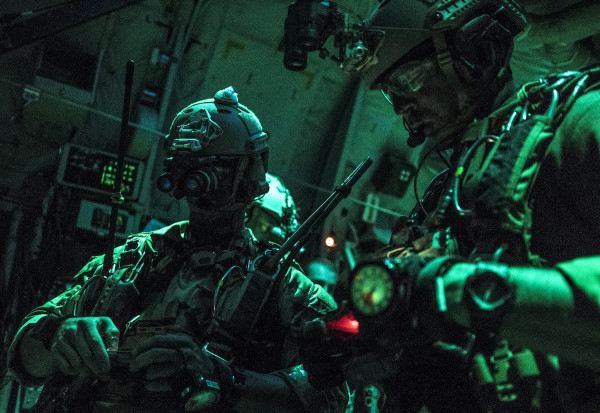

U.S. Special Operations Command over two years failed to adequately track whether hundreds of millions of dollars in specialized equipment fully met the key performance metrics for the special operations to whom it was fielded, according to a new audit from the Defense Department inspector general.
The DoD Office of the Inspector General audit, publicly released on Friday, set out to examine whether Special Operations-Peculiar (SO-P) equipment was thoroughly assessed as meeting mission requirements ahead of fielding to special operations forces from fiscal year 2017 to fiscal year 2019. SO-P equipment specifically refers to fancy tech unique to SOCOM units and runs the gamut from communications and surveillance gear to specialized vehicles and aircraft.
The audit covered 10 of SOCOM’s most expensive programs, totaling more than $1.4 billion and included: the AC-130J Ghost Rider Precision Strike Package Modification ($659.1 million); the wearable Tactical Local Area Network: Field Computing Device ($136.8 million); Small Glide Munition ($53.1 million); and Non-Standard Commercial Vehicle ($145.5 million); among others.
Of those 10 SO-P programs, only four, valued at around $494.1 million, were either completely validated by SOCOM personnel through testing and evaluation or at least fielded with their key performance shortfalls logged by SOCOM personnel for future adjustments.
But for the remaining six SO-P programs that culminated in the fielding of fresh gear — valued at an eye-popping $815.8 million — SOCOM personnel “did not verify” whether the gear had passed the required testing and evaluation prior to fielding to special operations forces, meaning the equipment was fielded “without verifying that the equipment meets user needs,” according to the audit.
According to a SOCOM spokesperson, the equipment detailed in the DoD OIG report works just fine and is currently employed by U.S. special operations forces in the field — the command just neglected to consistently document the results of equipment testing and evaluation for future review by the Pentagon watchdog.
“All the programs audited that are listed in the report had approved requirements confirming the need of each system for our operational forces. We validated that all systems were operationally effective and suitable through the OT&E prior to fielding,” Lt. Cmdr. Tim Hawkins, a SOCOM spokesperson, told Task & Purpose. “What we didn’t do was adequately document the results of meeting some of the individual key performance parameters. This is why SOCOM concurred with that finding and is taking steps to more thoroughly document and archive the key performance parameter results to resolve the audit findings.”

You’d think that the command responsible for training and equipping the U.S. military’s most elite forces might pay closer attention to tracking the efficacy of its expensive equipment, but the DoD OIG report details exactly how sloppy the testing and evaluation documentation process for some gear truly was. Consider this little excerpt on the Next Generation Tactical Communications program:
The USSOCOM program manager for Next Generation Tactical Communications program provided T&E documentation for the KPP that consisted of e-mails between a user and the equipment contractor in which the user stated that the equipment “worked great.” The e-mail communication did not provide sufficient information or evidence that the KPP was tested or passed T&E; therefore USSOCOM could not verify that KPP was tested and meet the requirements of the KPP outlined in the capability document.
This isn’t the first time SOCOM has run into trouble with the DoD OIG over the management of its SO-P programs. In 2018, a seperate audit found that SOCOM bought at least $26.3 million in extra gear ranging from handheld radios to night vision goggles.
“For example, USSOCOM did not identify that the U.S. Army Special Operations Command had 17,571 handheld radios according to its property records but was allocated only 13,351 in the capability documents, for an excess of 4,220 radios,” the DoD OIG reported at the time. “USSOCOM did not identify excess SO-P equipment because the authorized allowance and allocation data in the [USSOCOM Table of Equipment Distribution and Allowances] were not accurate or complete, and could not be reconciled with inventory.”
Related: SOCOM accidentally bought way, way too much combat gear
After years of mismanagement, it appears that SOCOM is finally paying a price. As National Defense Magazine notes, President Donald Trump’s fiscal year 2021 budget request included just $2.3 billion for procurement for SOCOM, 12 percent reduction compared to 2020, and a 26 percent drop compared to 2019.
“The FY 2021 budget for [Special Operations Forces] investments procures, modernizes, and/or modifies SOF-peculiar aviation, mobility, and maritime platforms, weapons, ordnance, and communications equipment,” the DoD said in its budget overview, per National Defense. “The FY 2021 budget sustains SOF growth and readiness, and increases lethality through modernization and recapitalization, and investing in new technologies.”
Part of this budget reduction is likely due to the Pentagon’s reorientation from counterinsurgency and counterterrorism in the Middle East and North Africa — areas where SOCOM has regularly served as the tip of the spear — towards so-called “great power competition” against more traditional adversaries like Russia and China.
But as one expert rightly pointed out to National Defense, the reduction also means a harsher spotlight on how SOCOM procures and evaluates fresh gear and equipment — and, potentially, more attention to how the command fails to evaluate its needs amid a slowly-changing mission set.
“Now we’re going to have to have a lot more scrutiny so that the equipment buys and equipment usage that we come up with is going to have to be useful in both fights,” Heritage Foundation analyst and former Special Forces Steven Bucci told National Defense. “That’s the only way SOCOM is going to maintain the capability that it needs to do both [missions].”